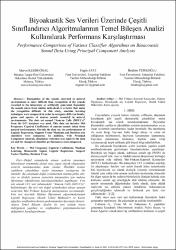| dc.contributor.author | Onal, Merve Kesim | |
| dc.contributor.author | Avcı, Engin | |
| dc.contributor.author | Türkoğlu, İbrahim | |
| dc.date.accessioned | 2021-06-11T16:42:38Z | |
| dc.date.available | 2021-06-11T16:42:38Z | |
| dc.date.issued | 2019 | en_US |
| dc.identifier.citation | Onal, M. K., Avcı, E., & Türkoğlu, i., (2019) Biyoakustik ses verileri üzerinde çeşitli sınıflandırıcı algoritmalarının temel bileşen analizi kullanılarak performans karşılaştırması. 2019 International Artificial Intelligence and Data Processing Symposium (IDAP), 1-6. | en_US |
| dc.identifier.isbn | 978-172812932-7 | en_US |
| dc.identifier.uri | https://doi.org/10.1109/IDAP.2019.8875968 | |
| dc.identifier.uri | https://hdl.handle.net/20.500.12899/220 | |
| dc.description.abstract | Doğal ortamlarda alınan seslerin tanınması
laboratuvar ortamında alınan veya yapay olarak oluşturulan
seslerin tanınmasından daha zordur. Özellikle benzer
canlıların çıkardıkları sesler tanınmayı zorlaştıran bir
etkendir. Bu çalışmada doğal ortamlardan alınmış farklı aile,
cins ve türdeki anuran seslerinin tanınmaları için makine
öğrenmesi tekniklerinin karşılaştırılmaları yapılmıştır. Veri
seti olarak UCI veri tabanındaki “Anuran Calls (MFCCs)”
kullanılmıştır. Bu veri seti doğal ortamlardan alınan anuran
seslerinin Mel Frekans Kepstral Katsayılarını içermektedir.
Veri seti üzerinde Makine Öğrenmesi algoritmalarından
Lojistik Regresyon, Destek Vektör Makineleri ve Karar
ağaçları sınıflandırıcılarınn performansları karşılaştırılmıştır.
Ayrıca Temel Bileşen Analizi ile veri setinde boyut
indirgemesi yapılmış ve sınıflandırıcı performanslarının
değişimleri karşılaştırılmıştır. | en_US |
| dc.description.abstract | Recognition of the sounds recorded in natural environments is more difficult than recognition of the sounds recorded in the laboratory or artificially generated. Especially the sounds taken from similar individuals is a factor that make the recognition difficult. In this study, machine learning techniques were compared in order to recognize different family, genus and species of anuran sounds recorded in natural environments. The data set named “Anuran Calls (MFCCs)” from the UCI database was used. This data set includes Mel Frequency Cepstral Coefficients of anuran sounds taken from natural environments. On this the data set, the performances of Logistic Regression, Support Vector Machines and Decision tree classifiers were compared. In addition, with Principal Component Analysis, dimension reduction was made in the data set and the changes in classifier performances were compared. | en_US |
| dc.language.iso | tr | en_US |
| dc.publisher | IEEE (Institute of Electrical and Electronics Engineers) | en_US |
| dc.relation.ispartof | 2019 International Artificial Intelligence and Data Processing Symposium (IDAP) 2019, Malatya, 21 - 22 September 2019 | en_US |
| dc.rights | info:eu-repo/semantics/closedAccess | en_US |
| dc.subject | Mel Frekans Kepstral Katsayıları | en_US |
| dc.subject | Makine öğrenmesi | en_US |
| dc.subject | Biyoakustik ses | en_US |
| dc.subject | Lojistik regresyon | en_US |
| dc.subject | Destek vektör makineleri | en_US |
| dc.subject | Karar ağaçları | en_US |
| dc.subject | Mel frequency cepstral coefficients | en_US |
| dc.subject | Machine learning | en_US |
| dc.subject | Bioacoustic signal | en_US |
| dc.subject | Logistic regression | en_US |
| dc.subject | Support vector machine | en_US |
| dc.subject | Decision trees | en_US |
| dc.title | Biyoakustik ses verileri üzerinde çeşitli sınıflandırıcı algoritmalarının temel bileşen analizi kullanılarak performans karşılaştırması | en_US |
| dc.title.alternative | Performance comparison of various classifier algorithms on bioacoustic sound data using principal component analysis | en_US |
| dc.type | Conference Object | en_US |
| dc.authorid | 0000-0001-8204-846X | en_US |
| dc.department | MTÖ Üniversitesi, Hekimhan Meslek Yüksekokulu, Madencilik ve Maden Çıkarma Bölümü | en_US |
| dc.institutionauthor | Onal, Merve Kesim | |
| dc.identifier.doi | 10.1109/IDAP.2019.8875968 | |
| dc.identifier.startpage | 1 | en_US |
| dc.identifier.endpage | 6 | en_US |
| dc.relation.publicationcategory | Konferans Öğesi - Uluslararası - Kurum Öğretim Elemanı | en_US |
| dc.identifier.scopus | 2-s2.0-85074889033 | en_US |
| dc.indekslendigikaynak | Web of Science | en_US |


















